The following blog post was written by a 2014 National Science Foundation (NSF) funded Research Experience for Undergraduates (REU) student following their internship at BIOS.
Hello from Bermuda!
My name is Mia Thomas and I am a junior at St. Lawrence University studying chemistry and environmental studies. I am currently working in the Coral Reef lab with my mentor Dr. Samantha de Putron on the project, “The effect of environmental variables on spat growth and zooxanthellae density of juvenile coral.” I am looking at how temperature, light, feeding and larval size affect growth rates of juveniles of the coral Porites astreoides in experimental tanks by measuring images of the corals taken every four weeks. I am also quantifying zooxanthellae density, an algal symbiont that lives within the coral, to further understand factors that affect this vital symbiosis and the relationship between zooxanthellae density and the coral’s growth.
Along with my research I have been taking the AAUS Research Diving Methods course to become a scientific diver. I attend weekly classes, take an extensive final exam, and have to complete 12 scientific dives for my certification. My final and favorite scientific dive of the semester was assisting Tim Noyes in coral coring!
 |
| This is an photo of me at the dive site where the samples were taken, about 8 miles off the shore of Bermuda. |
It was a beautiful mid-November day and the water was luckily quite warm. The PhD student Sara was well prepared and the sampling went smoothly.
 |
| Sara, the PhD student |
One of many things I love about about BIOS is meeting visiting scientists. They are all interested and passionate about such different aspects of marine science. Sara is looking at the pH within the coral and how it compares to the ambient sea water. Using these cores she will be able to essentially make an equation that will be able to determine what the pH of the seawater was when the coral colony first settled (maybe 100+ years ago!).
 |
| Diploria labyrinthiformis |
First we had to identify an adult colony that was large enough to core, close to the buoy, and of the correct species, Diploria labyrinthiformis. Photos were used to document the site so that in a year she can return and check on the health of the colony. This was one of the agreements with the Bermudian Government in order to sample the coral.
 |
| Dive slate indicating the coring sample |
A dive slate was used to help keep track of each core sample. The top line is the date, the second line is the scientific name abbreviation, "core" for coral coring, "3" is indicating that this is the the third coral colony sampled, and "A" is the first core in that colony (two were taken of each coral).
 |
| Tim using the drill to core the coral |
The coring drill was attached to a SCUBA cylinder, which made it very easy to maneuver under water. The tank had to be changed out after every core sample because the drill used so much air. It was honestly the coolest thing ever watching Tim drill because of all of the coral dust and bubbles going everywhere!
 |
| A finished coral core |
Learning how to conduct research underwater has changed the way I look at the marine ecosystem. Scientists are only just beginning to understand what is beneath the surface and with global climate change occurring, the more we know now, the better we will be able to predict and prevent the loss of this precious ecosystem!
*The Bermudian Government has strict rules about scientific collection to protect corals, and collecting a coral without a permit is against the law. Even touching corals can cause damage or spread disease, so this is something recreational divers should never do!
.JPG)

.jpg)
.jpg)












